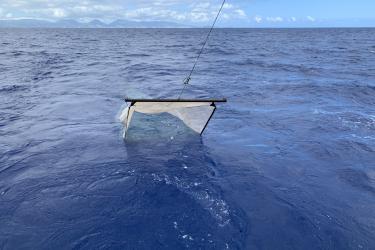“Permission to come along side.”
“Permission granted.”
If you were listening with a VHF radio on channel 82a on August 21, you would have heard this exchange take place between several of our small boats out in Kāneʻohe Bay, O‘ahu. Our team officially began heavy training for our mission to remove debris from the Northwestern Hawaiian Islands. When we are working in the Papahānaumokuākea Marine National Monument, we will be operating boats, free-diving, and hauling out heavy loads of derelict fishing gear and other debris from the beautiful, isolated islands.

Therefore, it was only fitting to begin our training in the NOAA Motorboat (small boat) Operations Course and Open Water Module. Although it is only a 5-day course, by the fifth and final day in the bay, we had practiced charting, pulling boats alongside each other, towing, rescuing people and boats, navigating with and without a GPS, assessing and managing risks, and maneuvering small boats in swell near surf zones.

The small boat courses were immediately followed by a 3-day, free-diver training course. We took the beginner course and it was incredible how much we learned! All of us pushed our limits, carefully and safely, and practiced preparing for and preventing shallow water blackouts by using specific breathing techniques and recovery breaths. As a scuba diver, I was taught that when you bring an unconscious victim to the surface, you immediately give them two breaths, but I never understood why, until the instructors explained. The first breath is meant to loosen the muscles in the throat that tighten to keep the water from getting in your lungs and the second breath is the air that actually reaches the lungs. After that, you can continue to give one breath every 5 seconds.
It really was an incredible course. We did some static breath holds where we floated face-down in the pool to see how long we could hold our breath. With proper breath-ups, some of us could hold our breaths for a whole 4 minutes! We practiced proper fin techniques and neck positions, so that on our last open water day, most of us were able to free dive down to 66 feet without any problems! I, personally, had no idea I could do that. I had only ever gone to 33 feet at the deepest.
We had more training to complete before we took off on our mission, but small boat and free-diver training was an absolute blast!
Meet the Blogger

You can make a difference
Try a bamboo toothbrush instead of traditional plastic toothbrushes.
Follow the team as we travel to the islands and atolls of the Northwestern Hawaiian Islands with photos and updates on our Story Map.
Partners
NOAA Fisheries marine debris project in the Pacific Islands region is supported by NOAA (Pacific Islands Fisheries Science Center, Pacific Islands Regional Office, Marine Debris Program, National Marine Sanctuaries, and the Damage Assessment Remediation and Restoration Program) in partnership with the University of Hawai'i's Joint Institute for Marine and Atmospheric Research, National Fish and Wildlife Foundation, U.S. Fish and Wildlife Service, Midway Atoll National Wildlife Refuge, the State of Hawai'i’s Department of Land and Natural Resources, and the Papahānaumokuākea Marine National Monument.



